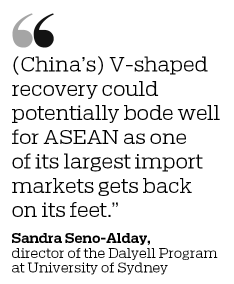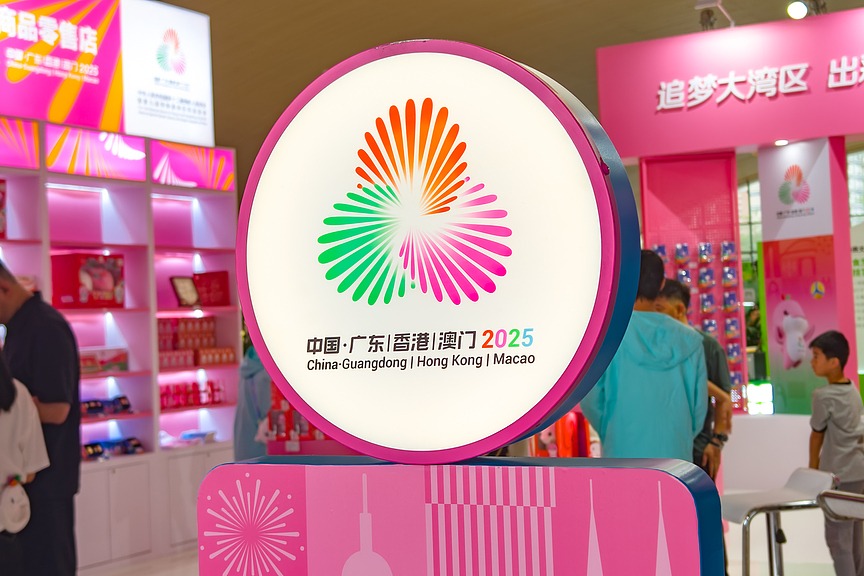China rebound spells positive news for Asia
Disrupted manufacturing, trade and investment flows expected to revive

China's economic rebound bodes well for Southeast and East Asian countries, stimulating regional growth even amid a pandemic, analysts said.
Bouncing back from its year-on-year contraction in the first quarter, the world's second-biggest economy posted 3.2 percent growth in the April-June quarter. The recovery is not only good news for China but also for Asia.
"China's economic recovery is a good omen for Southeast Asia and the rest of the world," said Lucio Blanco Pitlo III, research fellow at Asia-Pacific Pathways to Progress, a Manila-based foreign policy think tank.
Pitlo said China's rebound will revive manufacturing, trade and investment flows that were disrupted by the COVID-19 outbreak, which is good news for Southeast Asian exporters of farm products and intermediate goods who rely on the Chinese market. The region can learn from China's experience in reviving an economy while keeping COVID-19 at bay.
At a video conference of the Association of Southeast Asian Nations, China, Japan and South Korea, or ASEAN Plus Three, officials on Monday agreed to cooperate in promoting economic recovery, mitigating the impact of the pandemic and completing the signing of the Regional Comprehensive Economic Partnership, or RCEP.
"China, Japan and South Korea took different approaches in dealing with COVID-19 and they can share lessons with ASEAN," Pitlo said. He also welcomed the planned signing of RCEP, noting that a new free trade agreement like RCEP can help with economic recovery.
Nathan Chow, economist at Singapore-based DBS Bank, said the region is "the prime beneficiary of China's recovery, especially on the manufacturing and trade fronts".
Meanwhile, according to data released by China's General Administration of Customs, ASEAN was China's largest trading partner in the first half. During the period, ASEAN's 10 member countries together accounted for 14.7 percent of China's total foreign trade, while China's trade with the EU and the US declined by 1.8 percent and 6.6 percent, respectively.
Chow said that while the US remained China's largest single-country export market, its share has declined to 15.5 percent, from over 19.2 percent in 2018. He attributed this to the "increasingly fraught" China-US relationship.
He said that "less stringent transportation restrictions" also propped up China's trade with nearby countries, which eased the curbs to facilitate business trade during the pandemic.
In June, Singapore and Cambodia signed an agreement with China to fast-track business travel. The creation of travel bubbles is one of the measures that Southeast Asian governments are implementing to jump-start their economies without sacrificing public health.
While the region has achieved relative success in curbing the spread of the novel coronavirus, with fewer confirmed cases, a lower fatality rate and a higher recovery rate, shutting borders and enforcing mobility restrictions has also halted investment flows, disrupted the supply chain and slashed tourism revenues.
Record low growth rates
Southeast Asia's three biggest economies posted record low growth rates in the first quarter. Indonesia's GDP for January-March increased by 2.97 percent-the weakest pace since 2001; Malaysia's economy expanded at 0.7 percent, the lowest since 2009; and Thailand's economy contracted by 1.8 percent in the first quarter-its worst performance since 2011.
Singapore, the region's financial and trade center, is in technical recession, with its second-quarter GDP contracting by 12.6 percent.
China's recovery, supported by increased industrial output and economic packages offered by the government, has extended a lifeline to Southeast Asia.
Alicia Garcia-Herrero, chief economist for Asia-Pacific at French investment bank Natixis, said China's economic recovery is "a tailwind" for Southeast Asia.
And citing the close economic ties between the two sides, Garcia-Herrero said that "improved Chinese demand will help lift trade performance for ASEAN countries".
Indeed, the first-half trade data between China and ASEAN is a continuation of a longer trend, and is one of the several planks that support this economic partnership.
Sandra Seno-Alday, director of the Dalyell Program at University of Sydney's Business School, said China's "V-shaped recovery could potentially bode well for ASEAN as one of its largest import markets gets back on its feet".






























